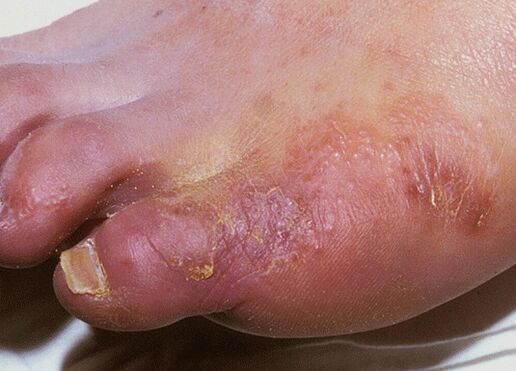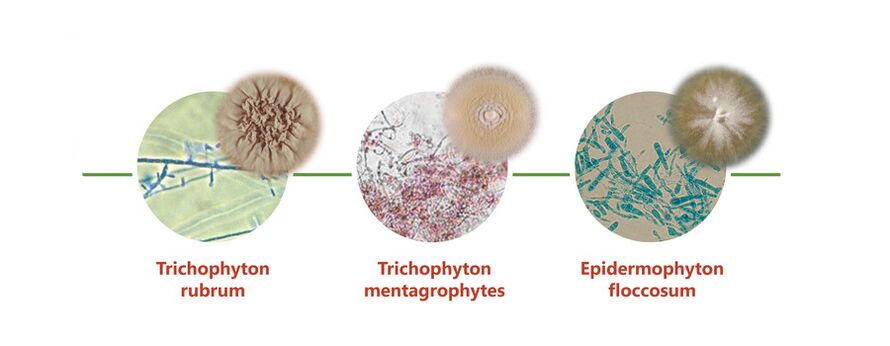Skin fungus is the most common dermatological disease. But the defeat on the legs is considered the most common. Mycoses of the legs and onychomycosis are common in people who visit public places, especially hospitals, saunas, baths, swimming pools and gyms.
Each type of fungus has its own characteristics, signs and treatment methods that you need to know for those at risk of fungal infection.
What is athlete's foot?
Mycosis or ringworm is a dermatological disease caused by a fungal pathogen. The fungus of the skin of the legs is the most common type of this disease, since the skin on the legs is more sensitive, which, moreover, is constantly exposed to the external environment affected by fungus.
risk factors
Athlete's foot is common in men who prefer closed-toe shoes. The feet begin to sweat and a breeding environment is created. Therefore, most men who served in the army know firsthand what a skin fungus is. In children, fungal infections occur due to non-compliance with hygiene rules, walking barefoot on contaminated soil, non-compliance with sanitary standards in kindergartens.

Often, athlete's foot infections also occur in women with hormonal disorders or a decrease in immunity during pregnancy. Even with a pedicure, infection can occur through unsterile instruments or towels.
There are common factors that provoke the development of the disease:
- Wearing shoes made of synthetic materials that are too tight.
- Rarely washing feet, wearing dirty socks.
- Wearing someone else's shoes, using someone else's towels and other hygiene items.
- Diseases that disrupt blood flow to the lower extremities.
- disorders of the immune system.
- Failure to comply with hygiene rules in public places.
- The presence of corns, sores and cracks on the feet.
- Long-term treatment with antibiotics or corticosteroids.
psychosomatics
The causes of the fungus can also lie in the emotional state of a person. The medical direction that studies the mental state of a person and its influence on the development of physical diseases - psychosomatics - explains fungal infections by suppressing internally retained negative emotions.
Constant feelings of resentment, anger, betrayal, or frustration can trigger the fungus or prevent a person from making a full recovery.
As a result of these conditions, human immunity is reduced, pathogens present in the body are activated. People with a chronic yeast infection that does not clear up with drug treatment need to reconsider their internal condition or consult a psychologist.
According to many scientists who have studied the psychosomatic causes of the fungus, if you do not work on your character and get rid of negative emotions, the disease will always return.
pathogens
There are a large number of pathogenic microorganisms that can cause human skin lesions, but the following types of fungi are most often localized on the legs:
- Trichophyton rubrum or Tripchophyton purpureum- cause rubromycosis, a disease that most commonly affects the skin of the feet and nails but can also spread to other parts of the body.
- Trichophyton interdigitale or Trichophyton mentagrophytes (Trichophytons)- Cause epidermophytosis, which develops between the fingers but can also affect the entire foot area.
- Candida- Candida rarely occurs on the feet, but can also affect the spaces between the toes, the nails and the soles of the feet. It develops predominantly in women.

Mycosis is an infection, and infection can occur in two ways: direct - directly from an infected person to a person, and indirect - through the floor, shoes, clothes and other household items with which the infected person has come into contact. It is very easy to become infected with a fungus of the lower extremities - just a second contact with a surface or object touched by a person with a fungal infection is enough.
The mechanism of development of fungal diseases begins with the penetration of spores into human skin. When conditions are favourable, development, growth and reproduction begin.
Microorganisms begin to secrete enzymes that destroy keratin proteins and, accordingly, the stratum corneum of the skin. Therefore, itching and discomfort appear in humans. The infection spreads very quickly, fungi penetrate into the deeper layers of the skin and infect the surrounding tissues.
If you do not start treatment, large areas of skin will be affected very quickly.
But the infection does not always develop immediately after infection, sometimes the fungi remain on the skin or shoes for a long time. But as soon as the body's defenses weaken or a favorable warm and humid environment develops, fungi begin to develop quickly.
General Symptoms
Lower extremity ringworm is a very common infection that requires immediate treatment. However, not everyone immediately turns to a specialist for help because they do not pay attention to the primary symptoms or consider them to be signs of other dermatological diseases.
Common signs of skin infection are:
- Redness and peeling of individual areas.
- The appearance of bubbles or cracks.
- Itching and burning sensation.
- dryness and roughness of the skin.
Depending on the localization and pathogen, the disease progresses with different clinical manifestations. The fungus on the heels begins with skin redness and burning. Over time, blisters appear, which when burst form very painful sores.
Then cracks and growths with exfoliation are formed. With a long course of the disease, an unpleasant odor begins to emanate from the affected area, and the infection spreads to other areas of the feet and nails.
Fungus on the knees is rare, but if cracks appear on or under the knee that do not go away for a long time, you need to see a doctor. Usually, the fungus in this area begins imperceptibly - it begins with redness, then peeling of the skin intensifies, very rarely blisters form on the surface of the site, which eventually become covered with scabs.
Damage to the nails - onychomycosis - begins with infection of the skin of the feet. In this case, itching and cracking of the skin may appear, but sometimes fungi do not touch the skin and affect only the nail plate.
Stages:
- normotrope- At this stage, only the color of the nail begins to change - it becomes yellow, sometimes with a brown tint.
- hypertrophic- The healthy shine of the nail disappears, it deforms irregularly, thickens and partially begins to break down. A person may experience pain when wearing tight shoes.
- onycholytic- The diseased nail is a plate with crumbling layers, becomes thinner and acquires a brown color. At this stage, detachment from the nail bed begins.
Manifestations of various types of pathologies
Candidiasis of the legs affects only soft areas of the skin and nails, without affecting the feet, it can be of two types:
- vesicular-pustular- In the first stage, reddening of the skin with pronounced edema occurs. In the future, the affected area is covered with blisters filled with a liquid or purulent mass, in the process they burst and form erosion. Gradually, the inflammatory process decreases, and peeling at the foci increases.
- Hyperkeratotic- is rare, characterized by thickening of the stratum corneum with the formation of scaly burgundy furrows.
In most cases, the fungus between the toes is epidermotrophy. Skin changes with this pathology can occur.jpg) the following forms:
the following forms:
- scaly- between the third and fourth fingers, the skin begins to redden and sometimes itch. Very often this phase is overlooked.
- intertriginous- evolves from the first stage. Edema develops, cracks form, and the lesion spreads to neighboring areas. Growths form around the diseased area, making it difficult to wear shoes.
- Acute- Large clusters of fluid-filled bubbles form. Wounds and cracks begin to hurt, general health deteriorates, the temperature can rise.
If the condition is neglected, then the interdigital pathology covers the nails and the entire area of \u200b\u200bthe sole of the foot, that is, epidermotrophy of the feet develops. External symptoms resemble weeping eczema, which makes diagnosis difficult.
Rubromycosis of the feet is a concomitant lesion of the interdigital folds. The skin becomes drier, reddens, severe peeling begins. If the treatment is not started on time, the process will spread to the sole, lateral part of the feet and the surface of the fingers.
Rubromycosis can also affect other parts of the legs: shins, thighs, buttocks, as well as all parts of the body and the head. The lesions are pink patches covered with scaly skin, blisters, or a crust. They quickly grow and merge with each other. Rubromycosis of smooth skin, as a rule, has an acute course and is accompanied by severe itching.
"I cracked my foot, but I wasn't careful. The fungus was discovered during an occupational health examination. The doctor immediately prescribed ointments and pills, she also complained that she didn't apply immediately.
The specifics of traditional treatment
Therapy of the fungus on the legs is based on the application of antifungal external agents to the lesions. There are many drugs in the form of ointments, creams, sprays, solutions. Their action is aimed at suppressing the vital activity and reproduction of fungi, as well as slowing down the process of their spread.
Recently, various sprays from the fungus have appeared, which are very convenient to use for external use in the treatment of skin and nail fungus.
During therapy, you can process shoes and clothes so as not to provoke re-infection. Disinfectant sprays are suitable for this. Treatment can also be carried out with antiseptics.
You can use antifungal drugs in the form of solutions.
Before applying ointments, you can use ordinary alcohol-salicylic acid solution. It has an active antifungal effect, while reducing inflammation and drying out weeping areas of the skin.
In case of damage to the nails, it is recommended to use special antifungal drugs.
There are many different topical remedies available and all are available from pharmacies without a prescription. But in order for the treatment to be effective, you need to know how to use external means correctly:
- Follow the instructions on how often to use the drug.
- Hard spots need to be steamed before applying the external agent.
- With large dry growths, you can make a bath with soda.
- Treat only the affected areas without affecting healthy skin.
- After treatment, wash your hands thoroughly without touching other parts of the body to avoid spreading the infection.
In advanced cases, you need to take tablets from the fungus at the same time with external means.You can not take pills without the recommendation of a doctor - only a specialist can prescribe medication based on the type of pathogen and the severity of the course of the disease.
Treatment of a fungal lesion on the legs at an early stage does not take much time, provided that the drugs are used correctly and the instructions are followed. In severe cases, long-term treatment of up to 3-6 months may be necessary. If the prescribed drugs do not give the desired effect, then you need to contact a specialist and get new recommendations.
"My husband treated the fungus on the lower extremities with various ointments, I tried 8 different ones, but only tablets from the group of triazole derivatives helped. Well, externally he continued to smear allylamine cream.
Folk methods of treatment
Very often, unconventional methods of treating fungus on the nails and legs are used.However, patients should remember that such funds are effective at the initial stage of the fungus, and in severe cases they can not always help, but, on the contrary, aggravate the course of the disease.
Before you get rid of the fungus on your feet with folk remedies, you need to see a doctor for an accurate diagnosis, since the symptoms can indicate various dermatological diseases.

Herbs from the fungus are used to prepare baths, liniments and lotions:
- Pour a handful of marigold flowers with 50 ml of alcohol and 100 ml of water and leave in a dark place for a day. Use twice a day for rubbing. Best for nail infections and candidiasis of the skin.
- Mix equal parts dry mint leaves and fine salt. Apply to affected areas for a day and secure with a bandage. When the time is up, remove the bandage, wash your feet, dry them and repeat the process. Use only on nails and keratinized skin.
- Five tablespoons of dry celandine pour 100 ml of vodka and leave for two weeks. Use it to wipe and try to avoid contact with healthy skin.
- Brew two tablespoons of thyme in a glass of boiling water, leave for an hour and use in lotions.
You can use tar soap from the mushroom:
- Grate a bar of soap, add a little water and melt in a water bath, add a spoonful of tar and 2 tablespoons of oil. Mix thoroughly and pour into molds to make a healing soap. Use it to wash your feet.
- Mix 1 tablespoon of crushed soap with 2 teaspoons of soda and add a little water to get a thick mixture. Apply to clean feet in the evening and place a bandage over them.
- In the initial course of the disease, it is sufficient to apply soapy water from laundry soap to the affected areas of the skin and leave it on for 15-30 minutes.
Effective garlic against fungi:
- Apply crushed garlic to the steamed areas and secure with a bandage. Hold up all night.
- Within 3 days, insist on a mixture of garlic juice, water and vodka, taken in equal parts. Rub the affected areas 1-2 times a day.
- Pour 2 finely chopped garlic cloves into a glass of vinegar. In a container with a closed lid, leave in a dark place for 2 weeks. Use for rubbing and lotions.
Vinegar can be used for rubbing or bathing. To prepare a bath, you need to take 100 ml of 9% table or apple cider vinegar for 1 liter of water. The duration of the procedure is 15 minutes. After that, you need to remove the softened skin and put on clean socks.
"I walk in shoes for days at work, my feet sweat constantly and fungus often appears on the foot. I immediately start making baths with vinegar and treating all my shoes with it. That goes by very quickly. "
consequences and predictions
Many believe that the fungus is not harmful, except for aesthetic ailments. But fungal infections also harbor other dangers. First, there is a risk that the fungus will spread to other areas of the skin.
From the feet, the infection spreads to the skin of the hands, face, torso, and scalp. This happens if you do not wash your hands after touching the affected areas of the skin, or if the patient's immunity is severely weakened. From an infected person, infection of family members occurs if hygiene rules are not followed.
With deep lesions, it is impossible to wear ordinary shoes, there is severe pain when walking, and if the nails are damaged, the nail bed increases. There is a risk of inflammation of the nerve endings.
Skin lesions, if left untreated, provoke the addition of viral and bacterial infections. The following complications are common:
- warts.
- phlegmon.
- pyoderma.
- erysipelas.
- Malignant mycosis fungoides.
A fungus of the skin on the legs with a long course worsens the functioning of the immune system, patients become more susceptible to allergic manifestations, urticaria, bronchial asthma, conjunctivitis and rhinitis. Mycoses are often accompanied by atopic dermatitis and eczema. The general condition worsens, weakness appears, body temperature may rise periodically.
Ongoing yeast infections can cause damage to internal organs.
In addition to physical complications, fungal infections lead to instability of the psycho-emotional state. Infected people become irritable, short-tempered, and often lash out at others. Nervous system instability slows recovery, so patients may need psychological support.
Toe fungus is very easy to cure if you start therapy at the very first manifestations of the disease. With daily use of therapeutic agents, the fungus can be eliminated in 10-14 days. However, with advanced infection, treatment becomes longer and more difficult and cannot do without the use of systemic drugs. Therefore, doctors recommend not to delay visiting the clinic.

















